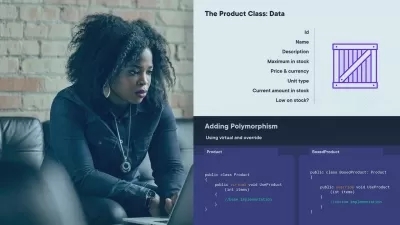Data-Oriented Programming, Video Edition
Focused View
9:43:11
75 View
001. Part 1. Flexibility.mp4
03:14
002. Chapter 1. Complexity of object-oriented programming.mp4
06:29
003. Chapter 1. UML 101.mp4
08:53
004. Chapter 1. Sources of complexity.mp4
09:06
005. Chapter 1. Not trivial data serialization.mp4
08:09
006. Chapter 1. Complex class hierarchies.mp4
07:48
007. Chapter 2. Separation between code and data.mp4
10:13
008. Chapter 2. Code modules.mp4
09:42
009. Chapter 2. DOP systems are easy to understand.mp4
11:45
010. Chapter 3. Basic data manipulation.mp4
09:24
011. Chapter 3. Representing records as maps.mp4
10:32
012. Chapter 3. Manipulating data with generic functions.mp4
07:03
013. Chapter 3. Calculating search results.mp4
08:18
014. Chapter 3. Handling records of different types.mp4
11:10
015. Chapter 4. State management.mp4
06:44
016. Chapter 4. Structural sharing.mp4
07:46
017. Chapter 4. Implementing structural sharing.mp4
08:49
018. Chapter 4. Ensuring system state integrity.mp4
08:51
019. Chapter 5. Basic concurrency control.mp4
10:56
020. Chapter 5. Reducing collections.mp4
10:34
021. Chapter 5. Implementing the reconciliation algorithm.mp4
05:35
022. Chapter 6. Unit tests.mp4
07:55
023. Chapter 6. Unit tests for functions down the tree.mp4
08:38
024. Chapter 6. Unit tests for queries.mp4
10:05
025. Chapter 6. Unit tests for mutations.mp4
09:36
026. Part 2. Scalability.mp4
05:54
027. Chapter 7. Basic data validation.mp4
04:58
028. Chapter 7. JSON Schema in a nutshell.mp4
09:00
029. Chapter 7. Schema flexibility and strictness.mp4
05:42
030. Chapter 7. Schema composition.mp4
10:16
031. Chapter 8. Advanced concurrency control.mp4
05:16
032. Chapter 8. Thread-safe counter with atoms.mp4
06:54
033. Chapter 8. Thread-safe cache with atoms.mp4
05:47
034. Chapter 9. Persistent data structures.mp4
06:52
035. Chapter 9. The efficiency of persistent data structures Part 1.mp4
07:19
036. Chapter 9. The efficiency of persistent data structures Part 2.mp4
06:00
037. Chapter 9. Persistent data structures libraries.mp4
08:24
038. Chapter 9. Persistent data structures in action.mp4
09:26
039. Chapter 10. Database operations.mp4
12:28
040. Chapter 10. Storing data in the database.mp4
10:04
041. Chapter 10. Advanced data manipulation.mp4
08:16
042. Chapter 11. Web services.mp4
12:03
043. Chapter 11. Representing a server response as a map.mp4
07:49
044. Chapter 11. Search result enrichment in action.mp4
08:57
045. Part 3. Maintainability.mp4
02:12
046. Chapter 12. Advanced data validation.mp4
07:21
047. Chapter 12. Function arguments validation.mp4
07:01
048. Chapter 12. Advanced data validation.mp4
08:19
049. Chapter 12. Automatic generation of schema-based unit tests.mp4
10:26
050. Chapter 13. Polymorphism.mp4
07:05
051. Chapter 13. Multimethods with single dispatch.mp4
07:46
052. Chapter 13. Multimethods with multiple dispatch.mp4
10:19
053. Chapter 13. Integrating multimethods in a production system.mp4
07:13
054. Chapter 14. Advanced data manipulation.mp4
07:48
055. Chapter 14. Manipulating nested data.mp4
10:55
056. Chapter 14. Unwinding at ease.mp4
06:09
057. Chapter 15. Debugging.mp4
08:26
058. Chapter 15. Reproducibility with numbers and strings.mp4
11:40
059. Chapter 15. Unit tests.mp4
10:15
060. Chapter 15. Dealing with external data sources.mp4
07:22
061. Appendix A. Principles of data-oriented programming.mp4
05:55
062. Appendix A. Benefits of Principle 1.mp4
08:28
063. Appendix A. Cost for Principle 1.mp4
10:19
064. Appendix A. Cost for Principle 2.mp4
06:50
065. Appendix A. Principle 3 Data is immutable.mp4
07:27
066. Appendix A. Cost for Principle 3.mp4
08:01
067. Appendix A. Benefits of Principle 4.mp4
06:41
068. Appendix B. Generic data access in statically-typed languages.mp4
10:38
069. Appendix B. Generic access to class members.mp4
06:50
070. Appendix C. Data-oriented programming A link in the chain of programming paradigms.mp4
05:39
071. Appendix C. DOP principles as best practices.mp4
07:26
More details
User Reviews
Rating
average 0
Focused display
Category

O'Reilly
View courses O'ReillyO'Reilly Media is an American learning company established by Tim O'Reilly that publishes books, produces tech conferences, and provides an online learning platform. Its distinctive brand features a woodcut of an animal on many of its book covers.
- language english
- Training sessions 71
- duration 9:43:11
- Release Date 2023/03/28










